University Report: MEDN2001 - Bronchodilator Salbutamol Analysis
VerifiedAdded on 2023/01/10
|12
|3227
|92
Report
AI Summary
This report provides a comprehensive analysis of Salbutamol, a bronchodilator medication used to treat respiratory disorders like asthma and chronic obstructive pulmonary disorder (COPD). It begins with an introduction to Salbutamol, classifying it as a short-acting beta-2 agonist, and explaining its role in relaxing airway muscles to improve airflow. The report delves into the pathophysiology of asthma, detailing how Salbutamol counteracts bronchospasms and bronchoconstriction. It then elucidates Salbutamol's mechanism of action, including its activation of beta-2 receptors, leading to the relaxation of bronchial smooth muscles. The report also addresses the drug's interactions with other disorders, such as heart conditions, diabetes, and seizure disorders, emphasizing the importance of careful patient assessment. Finally, it outlines critical considerations for healthcare professionals, including potential side effects and contraindications, ensuring safe and effective medication administration. The report emphasizes the necessity for nurses to understand the patient's medical history and potential drug interactions before administering Salbutamol.

Running head: BRONCHODILATOR
BRONCHODILATOR
Name of the student:
Name of the university:
Author note:
BRONCHODILATOR
Name of the student:
Name of the university:
Author note:
Paraphrase This Document
Need a fresh take? Get an instant paraphrase of this document with our AI Paraphraser
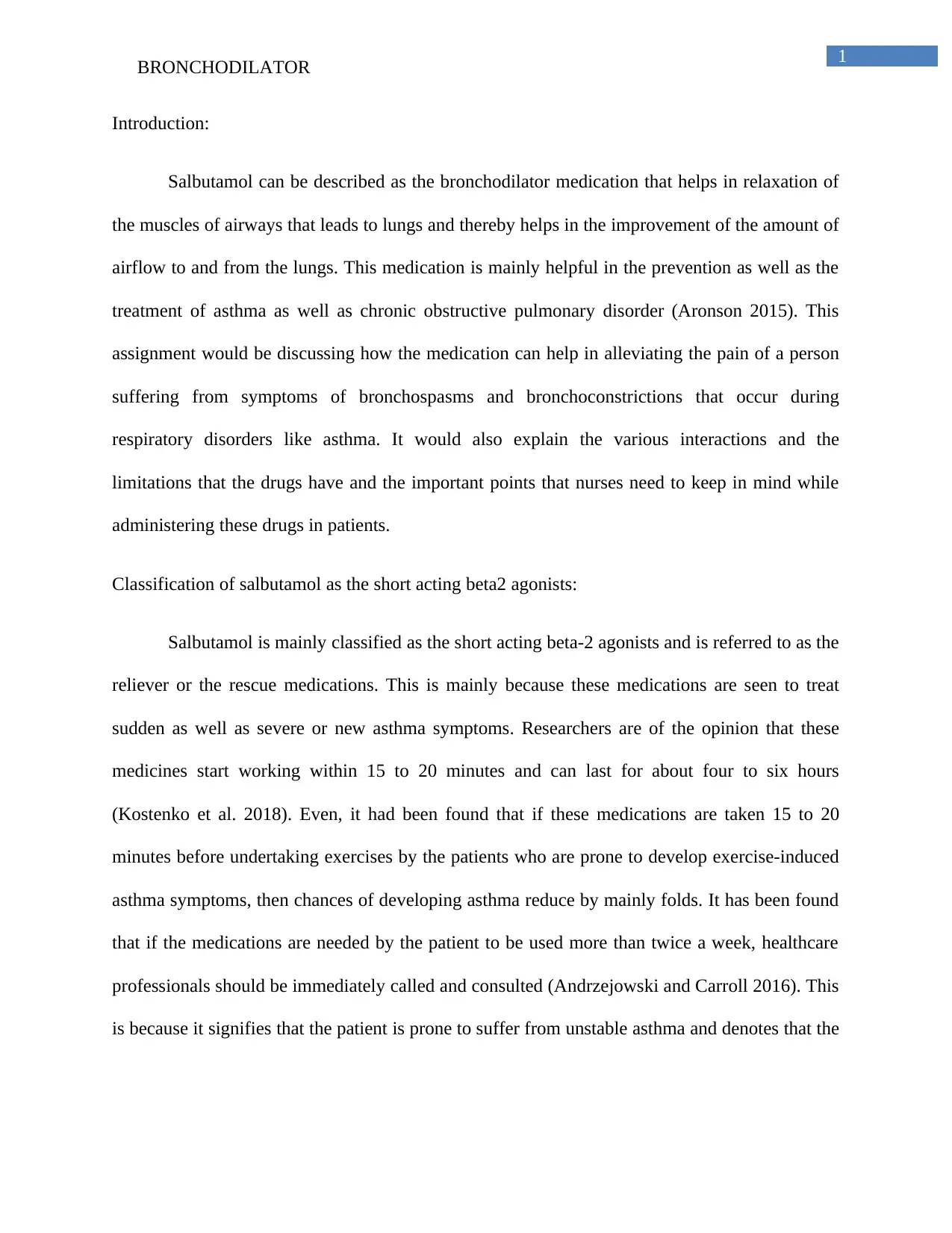
1
BRONCHODILATOR
Introduction:
Salbutamol can be described as the bronchodilator medication that helps in relaxation of
the muscles of airways that leads to lungs and thereby helps in the improvement of the amount of
airflow to and from the lungs. This medication is mainly helpful in the prevention as well as the
treatment of asthma as well as chronic obstructive pulmonary disorder (Aronson 2015). This
assignment would be discussing how the medication can help in alleviating the pain of a person
suffering from symptoms of bronchospasms and bronchoconstrictions that occur during
respiratory disorders like asthma. It would also explain the various interactions and the
limitations that the drugs have and the important points that nurses need to keep in mind while
administering these drugs in patients.
Classification of salbutamol as the short acting beta2 agonists:
Salbutamol is mainly classified as the short acting beta-2 agonists and is referred to as the
reliever or the rescue medications. This is mainly because these medications are seen to treat
sudden as well as severe or new asthma symptoms. Researchers are of the opinion that these
medicines start working within 15 to 20 minutes and can last for about four to six hours
(Kostenko et al. 2018). Even, it had been found that if these medications are taken 15 to 20
minutes before undertaking exercises by the patients who are prone to develop exercise-induced
asthma symptoms, then chances of developing asthma reduce by mainly folds. It has been found
that if the medications are needed by the patient to be used more than twice a week, healthcare
professionals should be immediately called and consulted (Andrzejowski and Carroll 2016). This
is because it signifies that the patient is prone to suffer from unstable asthma and denotes that the
BRONCHODILATOR
Introduction:
Salbutamol can be described as the bronchodilator medication that helps in relaxation of
the muscles of airways that leads to lungs and thereby helps in the improvement of the amount of
airflow to and from the lungs. This medication is mainly helpful in the prevention as well as the
treatment of asthma as well as chronic obstructive pulmonary disorder (Aronson 2015). This
assignment would be discussing how the medication can help in alleviating the pain of a person
suffering from symptoms of bronchospasms and bronchoconstrictions that occur during
respiratory disorders like asthma. It would also explain the various interactions and the
limitations that the drugs have and the important points that nurses need to keep in mind while
administering these drugs in patients.
Classification of salbutamol as the short acting beta2 agonists:
Salbutamol is mainly classified as the short acting beta-2 agonists and is referred to as the
reliever or the rescue medications. This is mainly because these medications are seen to treat
sudden as well as severe or new asthma symptoms. Researchers are of the opinion that these
medicines start working within 15 to 20 minutes and can last for about four to six hours
(Kostenko et al. 2018). Even, it had been found that if these medications are taken 15 to 20
minutes before undertaking exercises by the patients who are prone to develop exercise-induced
asthma symptoms, then chances of developing asthma reduce by mainly folds. It has been found
that if the medications are needed by the patient to be used more than twice a week, healthcare
professionals should be immediately called and consulted (Andrzejowski and Carroll 2016). This
is because it signifies that the patient is prone to suffer from unstable asthma and denotes that the
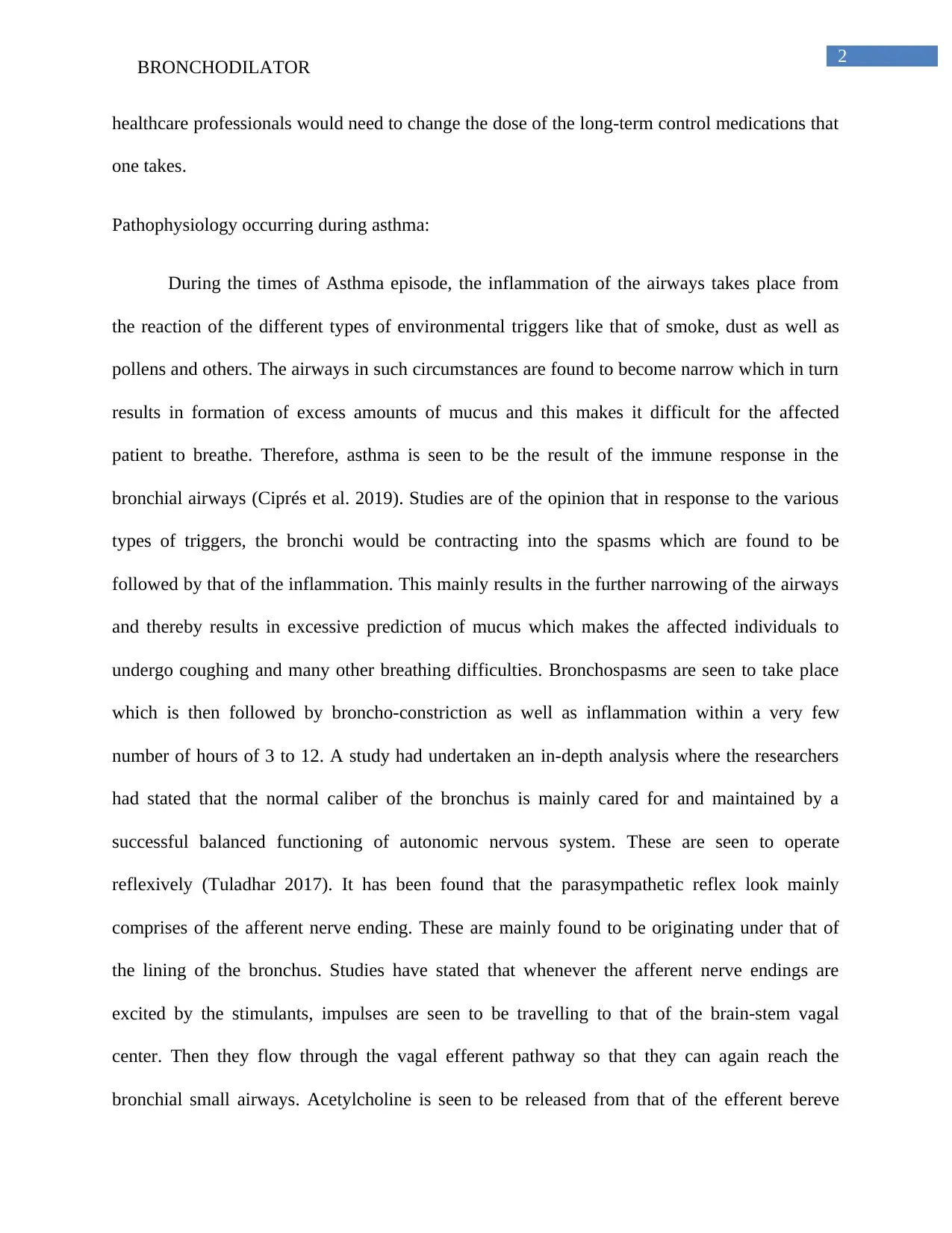
2
BRONCHODILATOR
healthcare professionals would need to change the dose of the long-term control medications that
one takes.
Pathophysiology occurring during asthma:
During the times of Asthma episode, the inflammation of the airways takes place from
the reaction of the different types of environmental triggers like that of smoke, dust as well as
pollens and others. The airways in such circumstances are found to become narrow which in turn
results in formation of excess amounts of mucus and this makes it difficult for the affected
patient to breathe. Therefore, asthma is seen to be the result of the immune response in the
bronchial airways (Ciprés et al. 2019). Studies are of the opinion that in response to the various
types of triggers, the bronchi would be contracting into the spasms which are found to be
followed by that of the inflammation. This mainly results in the further narrowing of the airways
and thereby results in excessive prediction of mucus which makes the affected individuals to
undergo coughing and many other breathing difficulties. Bronchospasms are seen to take place
which is then followed by broncho-constriction as well as inflammation within a very few
number of hours of 3 to 12. A study had undertaken an in-depth analysis where the researchers
had stated that the normal caliber of the bronchus is mainly cared for and maintained by a
successful balanced functioning of autonomic nervous system. These are seen to operate
reflexively (Tuladhar 2017). It has been found that the parasympathetic reflex look mainly
comprises of the afferent nerve ending. These are mainly found to be originating under that of
the lining of the bronchus. Studies have stated that whenever the afferent nerve endings are
excited by the stimulants, impulses are seen to be travelling to that of the brain-stem vagal
center. Then they flow through the vagal efferent pathway so that they can again reach the
bronchial small airways. Acetylcholine is seen to be released from that of the efferent bereve
BRONCHODILATOR
healthcare professionals would need to change the dose of the long-term control medications that
one takes.
Pathophysiology occurring during asthma:
During the times of Asthma episode, the inflammation of the airways takes place from
the reaction of the different types of environmental triggers like that of smoke, dust as well as
pollens and others. The airways in such circumstances are found to become narrow which in turn
results in formation of excess amounts of mucus and this makes it difficult for the affected
patient to breathe. Therefore, asthma is seen to be the result of the immune response in the
bronchial airways (Ciprés et al. 2019). Studies are of the opinion that in response to the various
types of triggers, the bronchi would be contracting into the spasms which are found to be
followed by that of the inflammation. This mainly results in the further narrowing of the airways
and thereby results in excessive prediction of mucus which makes the affected individuals to
undergo coughing and many other breathing difficulties. Bronchospasms are seen to take place
which is then followed by broncho-constriction as well as inflammation within a very few
number of hours of 3 to 12. A study had undertaken an in-depth analysis where the researchers
had stated that the normal caliber of the bronchus is mainly cared for and maintained by a
successful balanced functioning of autonomic nervous system. These are seen to operate
reflexively (Tuladhar 2017). It has been found that the parasympathetic reflex look mainly
comprises of the afferent nerve ending. These are mainly found to be originating under that of
the lining of the bronchus. Studies have stated that whenever the afferent nerve endings are
excited by the stimulants, impulses are seen to be travelling to that of the brain-stem vagal
center. Then they flow through the vagal efferent pathway so that they can again reach the
bronchial small airways. Acetylcholine is seen to be released from that of the efferent bereve
⊘ This is a preview!⊘
Do you want full access?
Subscribe today to unlock all pages.

Trusted by 1+ million students worldwide
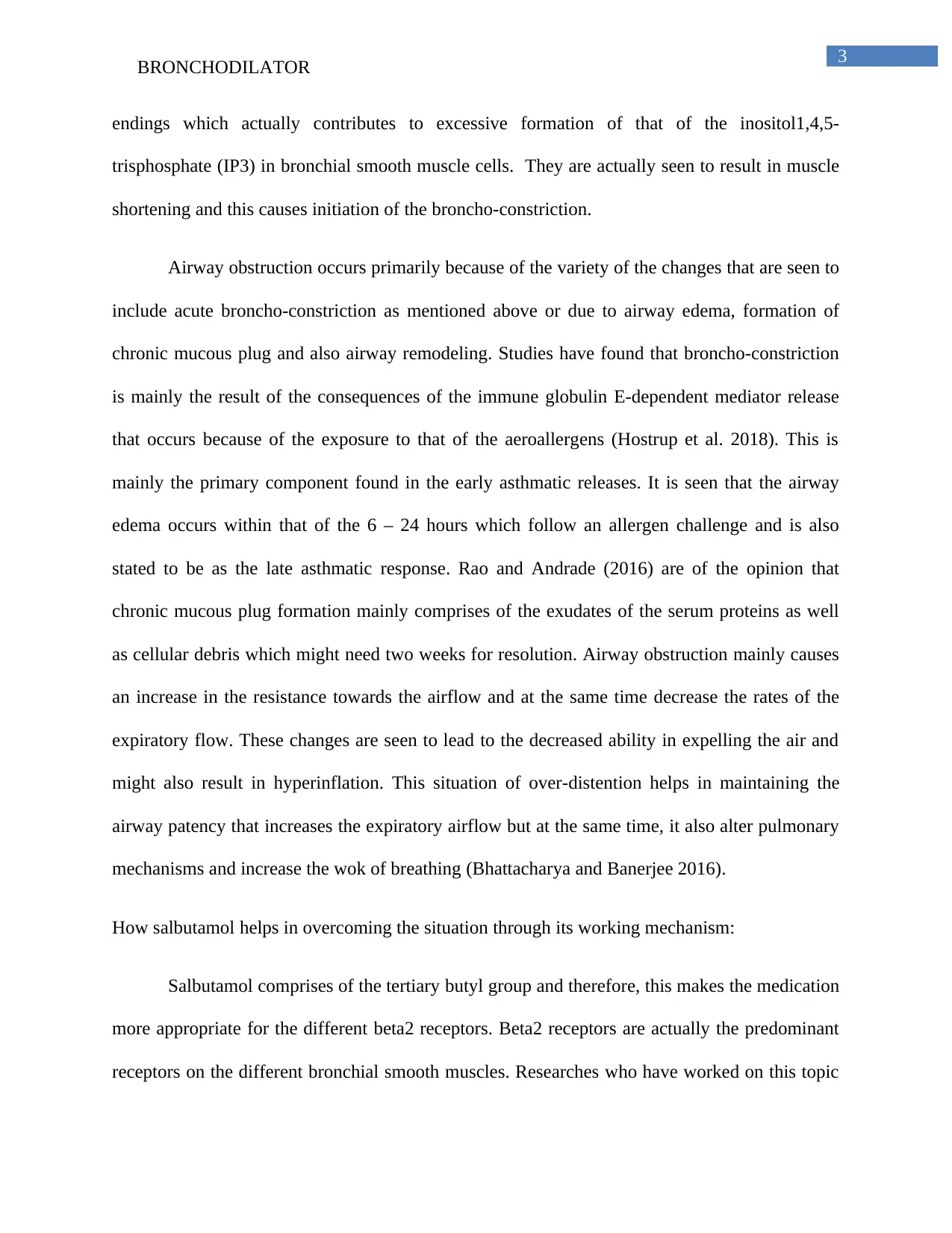
3
BRONCHODILATOR
endings which actually contributes to excessive formation of that of the inositol1,4,5-
trisphosphate (IP3) in bronchial smooth muscle cells. They are actually seen to result in muscle
shortening and this causes initiation of the broncho-constriction.
Airway obstruction occurs primarily because of the variety of the changes that are seen to
include acute broncho-constriction as mentioned above or due to airway edema, formation of
chronic mucous plug and also airway remodeling. Studies have found that broncho-constriction
is mainly the result of the consequences of the immune globulin E-dependent mediator release
that occurs because of the exposure to that of the aeroallergens (Hostrup et al. 2018). This is
mainly the primary component found in the early asthmatic releases. It is seen that the airway
edema occurs within that of the 6 – 24 hours which follow an allergen challenge and is also
stated to be as the late asthmatic response. Rao and Andrade (2016) are of the opinion that
chronic mucous plug formation mainly comprises of the exudates of the serum proteins as well
as cellular debris which might need two weeks for resolution. Airway obstruction mainly causes
an increase in the resistance towards the airflow and at the same time decrease the rates of the
expiratory flow. These changes are seen to lead to the decreased ability in expelling the air and
might also result in hyperinflation. This situation of over-distention helps in maintaining the
airway patency that increases the expiratory airflow but at the same time, it also alter pulmonary
mechanisms and increase the wok of breathing (Bhattacharya and Banerjee 2016).
How salbutamol helps in overcoming the situation through its working mechanism:
Salbutamol comprises of the tertiary butyl group and therefore, this makes the medication
more appropriate for the different beta2 receptors. Beta2 receptors are actually the predominant
receptors on the different bronchial smooth muscles. Researches who have worked on this topic
BRONCHODILATOR
endings which actually contributes to excessive formation of that of the inositol1,4,5-
trisphosphate (IP3) in bronchial smooth muscle cells. They are actually seen to result in muscle
shortening and this causes initiation of the broncho-constriction.
Airway obstruction occurs primarily because of the variety of the changes that are seen to
include acute broncho-constriction as mentioned above or due to airway edema, formation of
chronic mucous plug and also airway remodeling. Studies have found that broncho-constriction
is mainly the result of the consequences of the immune globulin E-dependent mediator release
that occurs because of the exposure to that of the aeroallergens (Hostrup et al. 2018). This is
mainly the primary component found in the early asthmatic releases. It is seen that the airway
edema occurs within that of the 6 – 24 hours which follow an allergen challenge and is also
stated to be as the late asthmatic response. Rao and Andrade (2016) are of the opinion that
chronic mucous plug formation mainly comprises of the exudates of the serum proteins as well
as cellular debris which might need two weeks for resolution. Airway obstruction mainly causes
an increase in the resistance towards the airflow and at the same time decrease the rates of the
expiratory flow. These changes are seen to lead to the decreased ability in expelling the air and
might also result in hyperinflation. This situation of over-distention helps in maintaining the
airway patency that increases the expiratory airflow but at the same time, it also alter pulmonary
mechanisms and increase the wok of breathing (Bhattacharya and Banerjee 2016).
How salbutamol helps in overcoming the situation through its working mechanism:
Salbutamol comprises of the tertiary butyl group and therefore, this makes the medication
more appropriate for the different beta2 receptors. Beta2 receptors are actually the predominant
receptors on the different bronchial smooth muscles. Researches who have worked on this topic
Paraphrase This Document
Need a fresh take? Get an instant paraphrase of this document with our AI Paraphraser
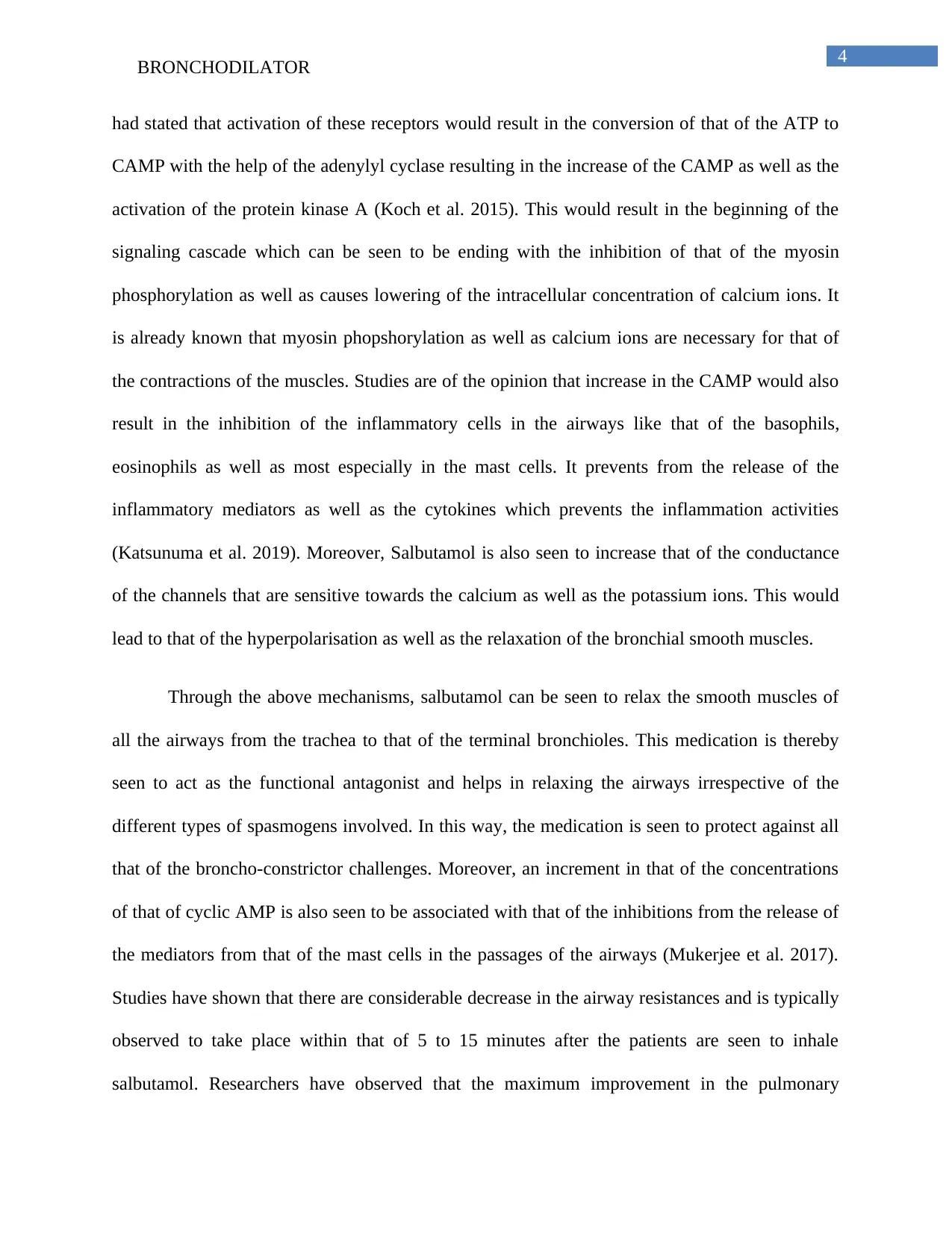
4
BRONCHODILATOR
had stated that activation of these receptors would result in the conversion of that of the ATP to
CAMP with the help of the adenylyl cyclase resulting in the increase of the CAMP as well as the
activation of the protein kinase A (Koch et al. 2015). This would result in the beginning of the
signaling cascade which can be seen to be ending with the inhibition of that of the myosin
phosphorylation as well as causes lowering of the intracellular concentration of calcium ions. It
is already known that myosin phopshorylation as well as calcium ions are necessary for that of
the contractions of the muscles. Studies are of the opinion that increase in the CAMP would also
result in the inhibition of the inflammatory cells in the airways like that of the basophils,
eosinophils as well as most especially in the mast cells. It prevents from the release of the
inflammatory mediators as well as the cytokines which prevents the inflammation activities
(Katsunuma et al. 2019). Moreover, Salbutamol is also seen to increase that of the conductance
of the channels that are sensitive towards the calcium as well as the potassium ions. This would
lead to that of the hyperpolarisation as well as the relaxation of the bronchial smooth muscles.
Through the above mechanisms, salbutamol can be seen to relax the smooth muscles of
all the airways from the trachea to that of the terminal bronchioles. This medication is thereby
seen to act as the functional antagonist and helps in relaxing the airways irrespective of the
different types of spasmogens involved. In this way, the medication is seen to protect against all
that of the broncho-constrictor challenges. Moreover, an increment in that of the concentrations
of that of cyclic AMP is also seen to be associated with that of the inhibitions from the release of
the mediators from that of the mast cells in the passages of the airways (Mukerjee et al. 2017).
Studies have shown that there are considerable decrease in the airway resistances and is typically
observed to take place within that of 5 to 15 minutes after the patients are seen to inhale
salbutamol. Researchers have observed that the maximum improvement in the pulmonary
BRONCHODILATOR
had stated that activation of these receptors would result in the conversion of that of the ATP to
CAMP with the help of the adenylyl cyclase resulting in the increase of the CAMP as well as the
activation of the protein kinase A (Koch et al. 2015). This would result in the beginning of the
signaling cascade which can be seen to be ending with the inhibition of that of the myosin
phosphorylation as well as causes lowering of the intracellular concentration of calcium ions. It
is already known that myosin phopshorylation as well as calcium ions are necessary for that of
the contractions of the muscles. Studies are of the opinion that increase in the CAMP would also
result in the inhibition of the inflammatory cells in the airways like that of the basophils,
eosinophils as well as most especially in the mast cells. It prevents from the release of the
inflammatory mediators as well as the cytokines which prevents the inflammation activities
(Katsunuma et al. 2019). Moreover, Salbutamol is also seen to increase that of the conductance
of the channels that are sensitive towards the calcium as well as the potassium ions. This would
lead to that of the hyperpolarisation as well as the relaxation of the bronchial smooth muscles.
Through the above mechanisms, salbutamol can be seen to relax the smooth muscles of
all the airways from the trachea to that of the terminal bronchioles. This medication is thereby
seen to act as the functional antagonist and helps in relaxing the airways irrespective of the
different types of spasmogens involved. In this way, the medication is seen to protect against all
that of the broncho-constrictor challenges. Moreover, an increment in that of the concentrations
of that of cyclic AMP is also seen to be associated with that of the inhibitions from the release of
the mediators from that of the mast cells in the passages of the airways (Mukerjee et al. 2017).
Studies have shown that there are considerable decrease in the airway resistances and is typically
observed to take place within that of 5 to 15 minutes after the patients are seen to inhale
salbutamol. Researchers have observed that the maximum improvement in the pulmonary
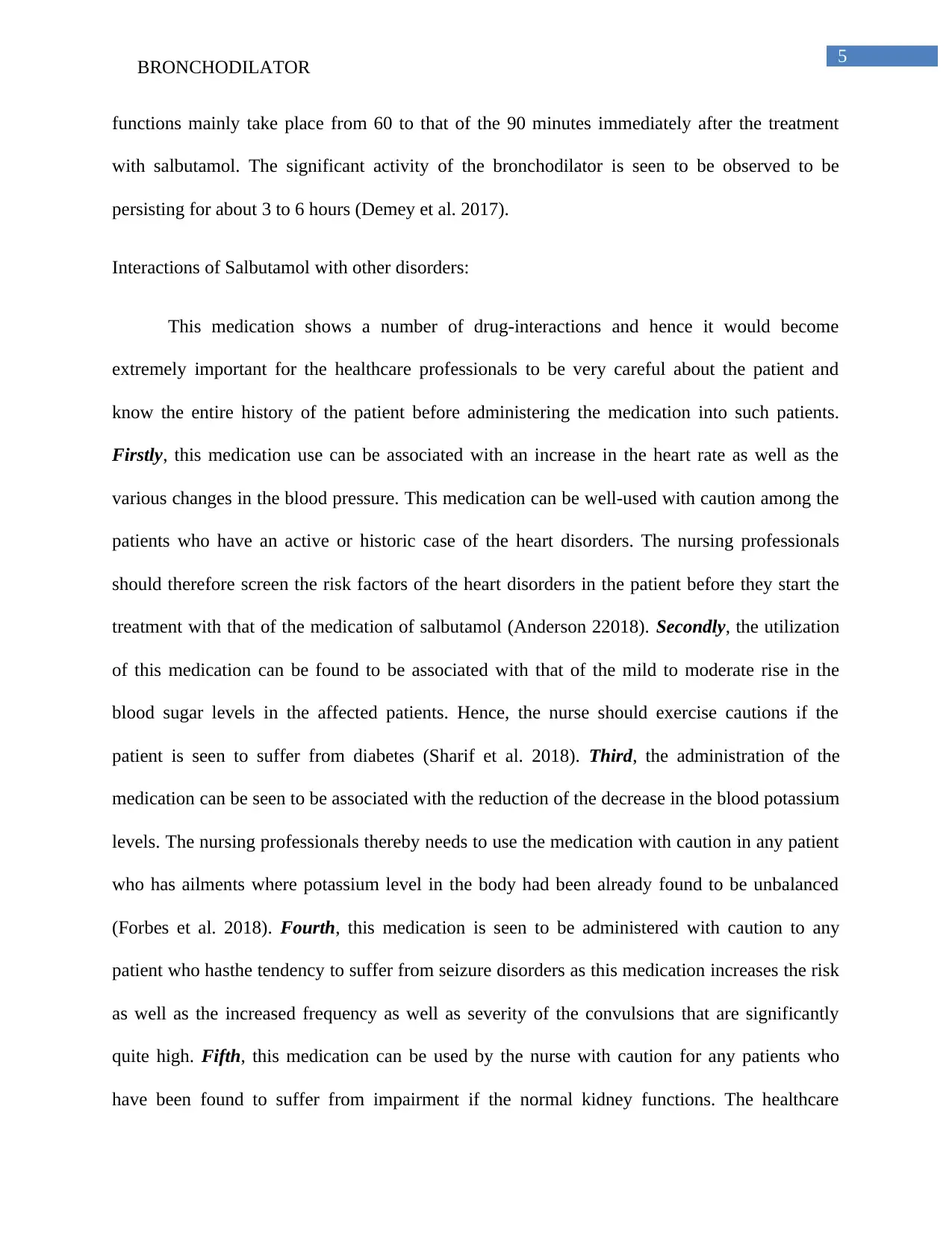
5
BRONCHODILATOR
functions mainly take place from 60 to that of the 90 minutes immediately after the treatment
with salbutamol. The significant activity of the bronchodilator is seen to be observed to be
persisting for about 3 to 6 hours (Demey et al. 2017).
Interactions of Salbutamol with other disorders:
This medication shows a number of drug-interactions and hence it would become
extremely important for the healthcare professionals to be very careful about the patient and
know the entire history of the patient before administering the medication into such patients.
Firstly, this medication use can be associated with an increase in the heart rate as well as the
various changes in the blood pressure. This medication can be well-used with caution among the
patients who have an active or historic case of the heart disorders. The nursing professionals
should therefore screen the risk factors of the heart disorders in the patient before they start the
treatment with that of the medication of salbutamol (Anderson 22018). Secondly, the utilization
of this medication can be found to be associated with that of the mild to moderate rise in the
blood sugar levels in the affected patients. Hence, the nurse should exercise cautions if the
patient is seen to suffer from diabetes (Sharif et al. 2018). Third, the administration of the
medication can be seen to be associated with the reduction of the decrease in the blood potassium
levels. The nursing professionals thereby needs to use the medication with caution in any patient
who has ailments where potassium level in the body had been already found to be unbalanced
(Forbes et al. 2018). Fourth, this medication is seen to be administered with caution to any
patient who hasthe tendency to suffer from seizure disorders as this medication increases the risk
as well as the increased frequency as well as severity of the convulsions that are significantly
quite high. Fifth, this medication can be used by the nurse with caution for any patients who
have been found to suffer from impairment if the normal kidney functions. The healthcare
BRONCHODILATOR
functions mainly take place from 60 to that of the 90 minutes immediately after the treatment
with salbutamol. The significant activity of the bronchodilator is seen to be observed to be
persisting for about 3 to 6 hours (Demey et al. 2017).
Interactions of Salbutamol with other disorders:
This medication shows a number of drug-interactions and hence it would become
extremely important for the healthcare professionals to be very careful about the patient and
know the entire history of the patient before administering the medication into such patients.
Firstly, this medication use can be associated with an increase in the heart rate as well as the
various changes in the blood pressure. This medication can be well-used with caution among the
patients who have an active or historic case of the heart disorders. The nursing professionals
should therefore screen the risk factors of the heart disorders in the patient before they start the
treatment with that of the medication of salbutamol (Anderson 22018). Secondly, the utilization
of this medication can be found to be associated with that of the mild to moderate rise in the
blood sugar levels in the affected patients. Hence, the nurse should exercise cautions if the
patient is seen to suffer from diabetes (Sharif et al. 2018). Third, the administration of the
medication can be seen to be associated with the reduction of the decrease in the blood potassium
levels. The nursing professionals thereby needs to use the medication with caution in any patient
who has ailments where potassium level in the body had been already found to be unbalanced
(Forbes et al. 2018). Fourth, this medication is seen to be administered with caution to any
patient who hasthe tendency to suffer from seizure disorders as this medication increases the risk
as well as the increased frequency as well as severity of the convulsions that are significantly
quite high. Fifth, this medication can be used by the nurse with caution for any patients who
have been found to suffer from impairment if the normal kidney functions. The healthcare
⊘ This is a preview!⊘
Do you want full access?
Subscribe today to unlock all pages.

Trusted by 1+ million students worldwide
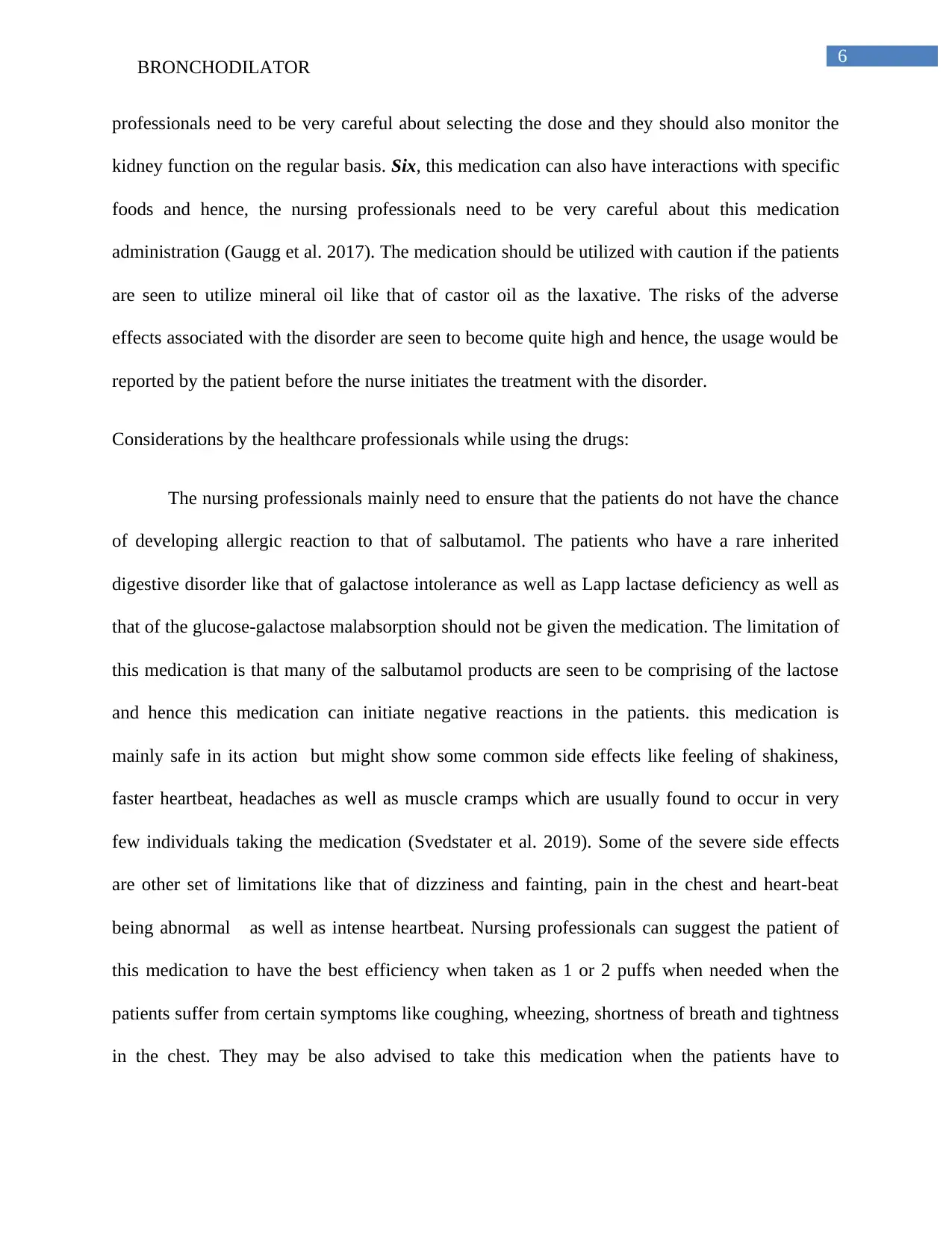
6
BRONCHODILATOR
professionals need to be very careful about selecting the dose and they should also monitor the
kidney function on the regular basis. Six, this medication can also have interactions with specific
foods and hence, the nursing professionals need to be very careful about this medication
administration (Gaugg et al. 2017). The medication should be utilized with caution if the patients
are seen to utilize mineral oil like that of castor oil as the laxative. The risks of the adverse
effects associated with the disorder are seen to become quite high and hence, the usage would be
reported by the patient before the nurse initiates the treatment with the disorder.
Considerations by the healthcare professionals while using the drugs:
The nursing professionals mainly need to ensure that the patients do not have the chance
of developing allergic reaction to that of salbutamol. The patients who have a rare inherited
digestive disorder like that of galactose intolerance as well as Lapp lactase deficiency as well as
that of the glucose-galactose malabsorption should not be given the medication. The limitation of
this medication is that many of the salbutamol products are seen to be comprising of the lactose
and hence this medication can initiate negative reactions in the patients. this medication is
mainly safe in its action but might show some common side effects like feeling of shakiness,
faster heartbeat, headaches as well as muscle cramps which are usually found to occur in very
few individuals taking the medication (Svedstater et al. 2019). Some of the severe side effects
are other set of limitations like that of dizziness and fainting, pain in the chest and heart-beat
being abnormal as well as intense heartbeat. Nursing professionals can suggest the patient of
this medication to have the best efficiency when taken as 1 or 2 puffs when needed when the
patients suffer from certain symptoms like coughing, wheezing, shortness of breath and tightness
in the chest. They may be also advised to take this medication when the patients have to
BRONCHODILATOR
professionals need to be very careful about selecting the dose and they should also monitor the
kidney function on the regular basis. Six, this medication can also have interactions with specific
foods and hence, the nursing professionals need to be very careful about this medication
administration (Gaugg et al. 2017). The medication should be utilized with caution if the patients
are seen to utilize mineral oil like that of castor oil as the laxative. The risks of the adverse
effects associated with the disorder are seen to become quite high and hence, the usage would be
reported by the patient before the nurse initiates the treatment with the disorder.
Considerations by the healthcare professionals while using the drugs:
The nursing professionals mainly need to ensure that the patients do not have the chance
of developing allergic reaction to that of salbutamol. The patients who have a rare inherited
digestive disorder like that of galactose intolerance as well as Lapp lactase deficiency as well as
that of the glucose-galactose malabsorption should not be given the medication. The limitation of
this medication is that many of the salbutamol products are seen to be comprising of the lactose
and hence this medication can initiate negative reactions in the patients. this medication is
mainly safe in its action but might show some common side effects like feeling of shakiness,
faster heartbeat, headaches as well as muscle cramps which are usually found to occur in very
few individuals taking the medication (Svedstater et al. 2019). Some of the severe side effects
are other set of limitations like that of dizziness and fainting, pain in the chest and heart-beat
being abnormal as well as intense heartbeat. Nursing professionals can suggest the patient of
this medication to have the best efficiency when taken as 1 or 2 puffs when needed when the
patients suffer from certain symptoms like coughing, wheezing, shortness of breath and tightness
in the chest. They may be also advised to take this medication when the patients have to
Paraphrase This Document
Need a fresh take? Get an instant paraphrase of this document with our AI Paraphraser
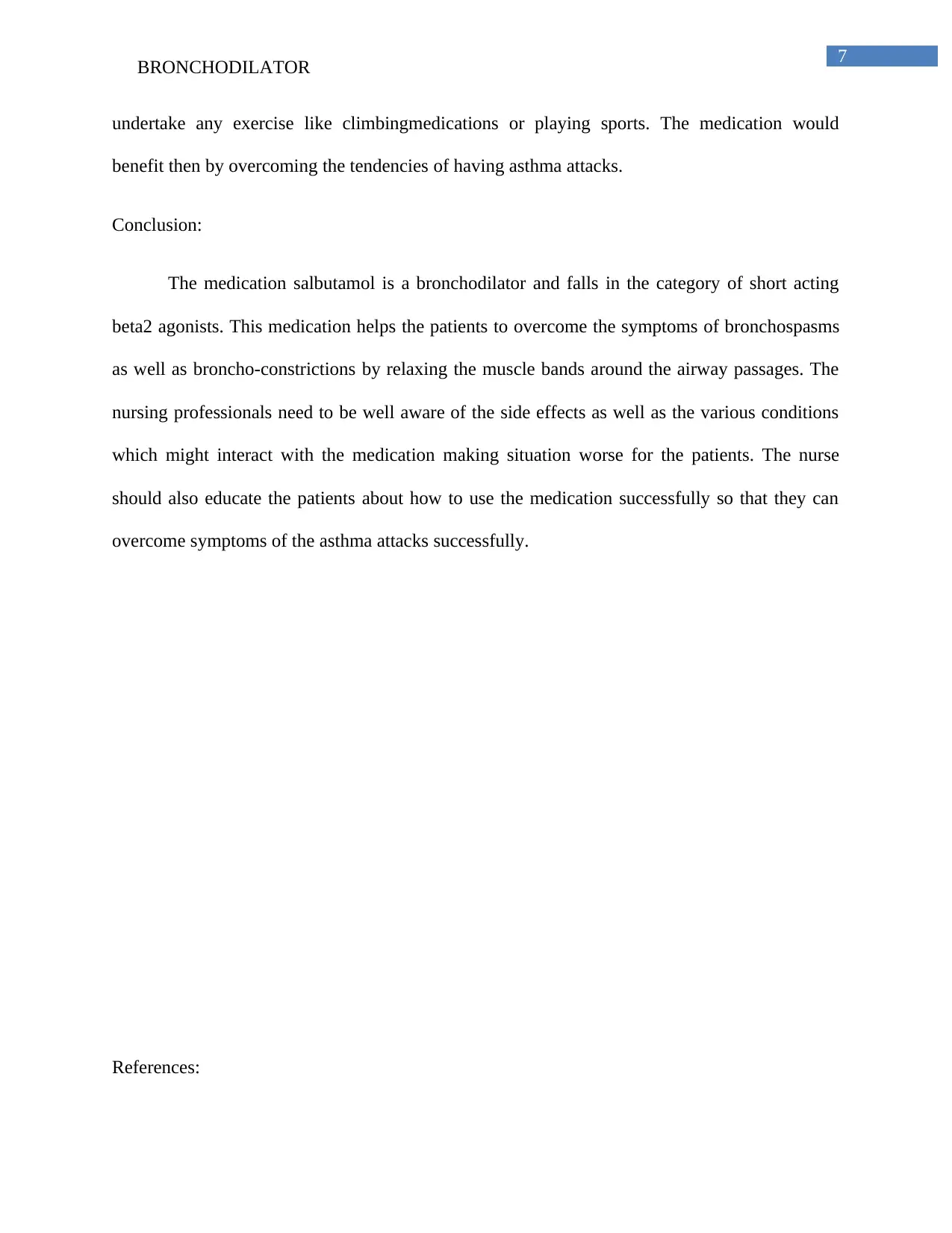
7
BRONCHODILATOR
undertake any exercise like climbingmedications or playing sports. The medication would
benefit then by overcoming the tendencies of having asthma attacks.
Conclusion:
The medication salbutamol is a bronchodilator and falls in the category of short acting
beta2 agonists. This medication helps the patients to overcome the symptoms of bronchospasms
as well as broncho-constrictions by relaxing the muscle bands around the airway passages. The
nursing professionals need to be well aware of the side effects as well as the various conditions
which might interact with the medication making situation worse for the patients. The nurse
should also educate the patients about how to use the medication successfully so that they can
overcome symptoms of the asthma attacks successfully.
References:
BRONCHODILATOR
undertake any exercise like climbingmedications or playing sports. The medication would
benefit then by overcoming the tendencies of having asthma attacks.
Conclusion:
The medication salbutamol is a bronchodilator and falls in the category of short acting
beta2 agonists. This medication helps the patients to overcome the symptoms of bronchospasms
as well as broncho-constrictions by relaxing the muscle bands around the airway passages. The
nursing professionals need to be well aware of the side effects as well as the various conditions
which might interact with the medication making situation worse for the patients. The nurse
should also educate the patients about how to use the medication successfully so that they can
overcome symptoms of the asthma attacks successfully.
References:
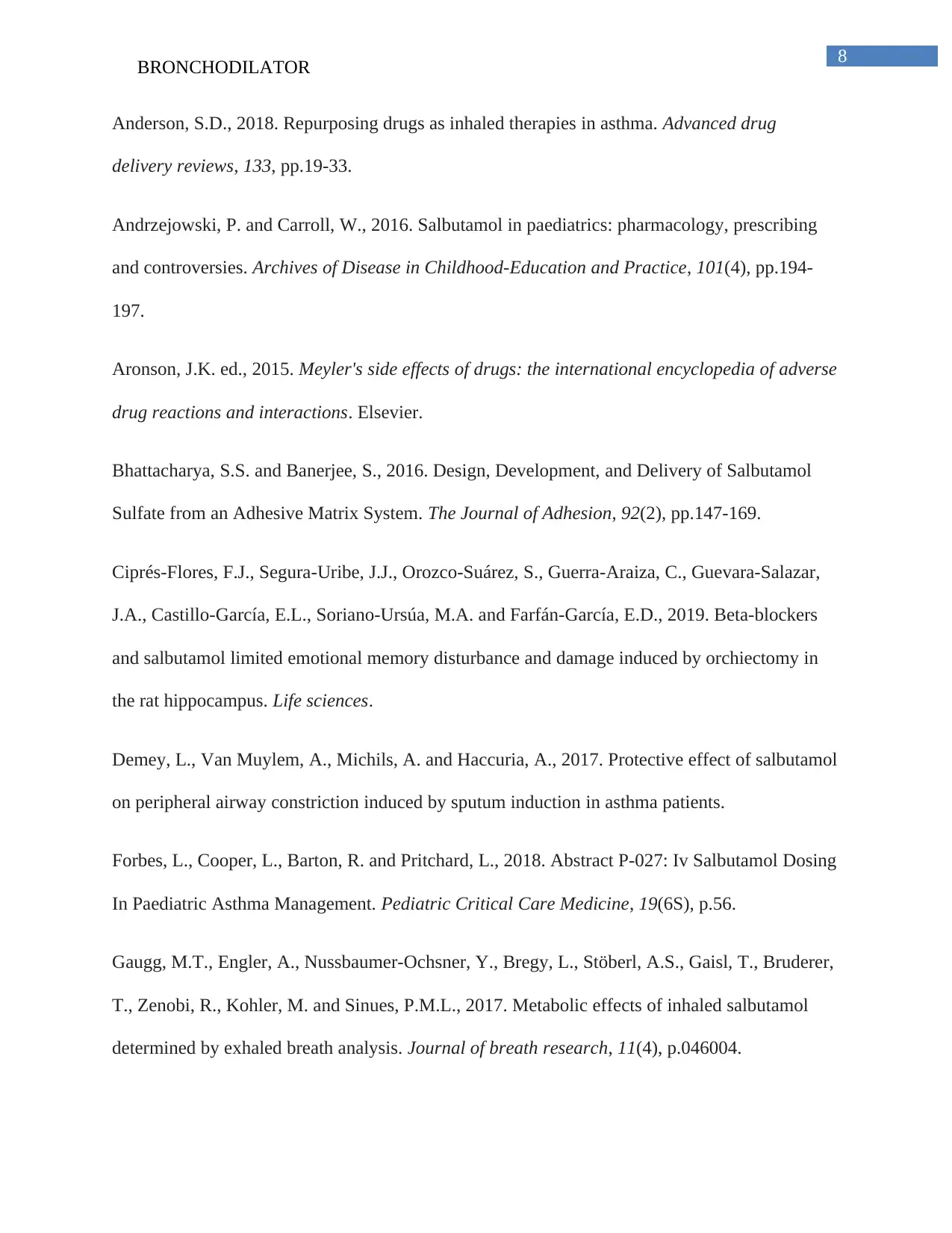
8
BRONCHODILATOR
Anderson, S.D., 2018. Repurposing drugs as inhaled therapies in asthma. Advanced drug
delivery reviews, 133, pp.19-33.
Andrzejowski, P. and Carroll, W., 2016. Salbutamol in paediatrics: pharmacology, prescribing
and controversies. Archives of Disease in Childhood-Education and Practice, 101(4), pp.194-
197.
Aronson, J.K. ed., 2015. Meyler's side effects of drugs: the international encyclopedia of adverse
drug reactions and interactions. Elsevier.
Bhattacharya, S.S. and Banerjee, S., 2016. Design, Development, and Delivery of Salbutamol
Sulfate from an Adhesive Matrix System. The Journal of Adhesion, 92(2), pp.147-169.
Ciprés-Flores, F.J., Segura-Uribe, J.J., Orozco-Suárez, S., Guerra-Araiza, C., Guevara-Salazar,
J.A., Castillo-García, E.L., Soriano-Ursúa, M.A. and Farfán-García, E.D., 2019. Beta-blockers
and salbutamol limited emotional memory disturbance and damage induced by orchiectomy in
the rat hippocampus. Life sciences.
Demey, L., Van Muylem, A., Michils, A. and Haccuria, A., 2017. Protective effect of salbutamol
on peripheral airway constriction induced by sputum induction in asthma patients.
Forbes, L., Cooper, L., Barton, R. and Pritchard, L., 2018. Abstract P-027: Iv Salbutamol Dosing
In Paediatric Asthma Management. Pediatric Critical Care Medicine, 19(6S), p.56.
Gaugg, M.T., Engler, A., Nussbaumer-Ochsner, Y., Bregy, L., Stöberl, A.S., Gaisl, T., Bruderer,
T., Zenobi, R., Kohler, M. and Sinues, P.M.L., 2017. Metabolic effects of inhaled salbutamol
determined by exhaled breath analysis. Journal of breath research, 11(4), p.046004.
BRONCHODILATOR
Anderson, S.D., 2018. Repurposing drugs as inhaled therapies in asthma. Advanced drug
delivery reviews, 133, pp.19-33.
Andrzejowski, P. and Carroll, W., 2016. Salbutamol in paediatrics: pharmacology, prescribing
and controversies. Archives of Disease in Childhood-Education and Practice, 101(4), pp.194-
197.
Aronson, J.K. ed., 2015. Meyler's side effects of drugs: the international encyclopedia of adverse
drug reactions and interactions. Elsevier.
Bhattacharya, S.S. and Banerjee, S., 2016. Design, Development, and Delivery of Salbutamol
Sulfate from an Adhesive Matrix System. The Journal of Adhesion, 92(2), pp.147-169.
Ciprés-Flores, F.J., Segura-Uribe, J.J., Orozco-Suárez, S., Guerra-Araiza, C., Guevara-Salazar,
J.A., Castillo-García, E.L., Soriano-Ursúa, M.A. and Farfán-García, E.D., 2019. Beta-blockers
and salbutamol limited emotional memory disturbance and damage induced by orchiectomy in
the rat hippocampus. Life sciences.
Demey, L., Van Muylem, A., Michils, A. and Haccuria, A., 2017. Protective effect of salbutamol
on peripheral airway constriction induced by sputum induction in asthma patients.
Forbes, L., Cooper, L., Barton, R. and Pritchard, L., 2018. Abstract P-027: Iv Salbutamol Dosing
In Paediatric Asthma Management. Pediatric Critical Care Medicine, 19(6S), p.56.
Gaugg, M.T., Engler, A., Nussbaumer-Ochsner, Y., Bregy, L., Stöberl, A.S., Gaisl, T., Bruderer,
T., Zenobi, R., Kohler, M. and Sinues, P.M.L., 2017. Metabolic effects of inhaled salbutamol
determined by exhaled breath analysis. Journal of breath research, 11(4), p.046004.
⊘ This is a preview!⊘
Do you want full access?
Subscribe today to unlock all pages.

Trusted by 1+ million students worldwide
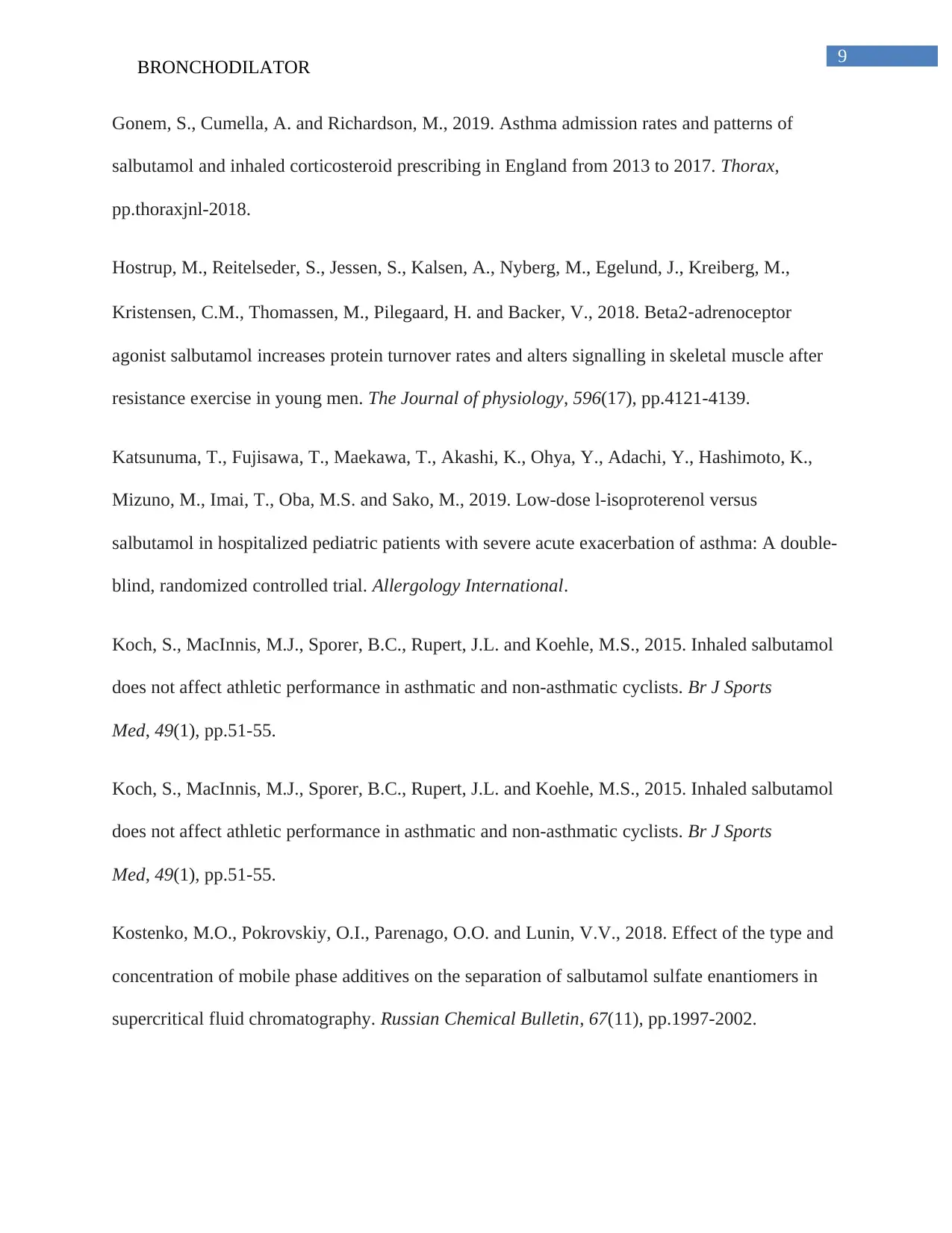
9
BRONCHODILATOR
Gonem, S., Cumella, A. and Richardson, M., 2019. Asthma admission rates and patterns of
salbutamol and inhaled corticosteroid prescribing in England from 2013 to 2017. Thorax,
pp.thoraxjnl-2018.
Hostrup, M., Reitelseder, S., Jessen, S., Kalsen, A., Nyberg, M., Egelund, J., Kreiberg, M.,
Kristensen, C.M., Thomassen, M., Pilegaard, H. and Backer, V., 2018. Beta2‐adrenoceptor
agonist salbutamol increases protein turnover rates and alters signalling in skeletal muscle after
resistance exercise in young men. The Journal of physiology, 596(17), pp.4121-4139.
Katsunuma, T., Fujisawa, T., Maekawa, T., Akashi, K., Ohya, Y., Adachi, Y., Hashimoto, K.,
Mizuno, M., Imai, T., Oba, M.S. and Sako, M., 2019. Low-dose l-isoproterenol versus
salbutamol in hospitalized pediatric patients with severe acute exacerbation of asthma: A double-
blind, randomized controlled trial. Allergology International.
Koch, S., MacInnis, M.J., Sporer, B.C., Rupert, J.L. and Koehle, M.S., 2015. Inhaled salbutamol
does not affect athletic performance in asthmatic and non-asthmatic cyclists. Br J Sports
Med, 49(1), pp.51-55.
Koch, S., MacInnis, M.J., Sporer, B.C., Rupert, J.L. and Koehle, M.S., 2015. Inhaled salbutamol
does not affect athletic performance in asthmatic and non-asthmatic cyclists. Br J Sports
Med, 49(1), pp.51-55.
Kostenko, M.O., Pokrovskiy, O.I., Parenago, O.O. and Lunin, V.V., 2018. Effect of the type and
concentration of mobile phase additives on the separation of salbutamol sulfate enantiomers in
supercritical fluid chromatography. Russian Chemical Bulletin, 67(11), pp.1997-2002.
BRONCHODILATOR
Gonem, S., Cumella, A. and Richardson, M., 2019. Asthma admission rates and patterns of
salbutamol and inhaled corticosteroid prescribing in England from 2013 to 2017. Thorax,
pp.thoraxjnl-2018.
Hostrup, M., Reitelseder, S., Jessen, S., Kalsen, A., Nyberg, M., Egelund, J., Kreiberg, M.,
Kristensen, C.M., Thomassen, M., Pilegaard, H. and Backer, V., 2018. Beta2‐adrenoceptor
agonist salbutamol increases protein turnover rates and alters signalling in skeletal muscle after
resistance exercise in young men. The Journal of physiology, 596(17), pp.4121-4139.
Katsunuma, T., Fujisawa, T., Maekawa, T., Akashi, K., Ohya, Y., Adachi, Y., Hashimoto, K.,
Mizuno, M., Imai, T., Oba, M.S. and Sako, M., 2019. Low-dose l-isoproterenol versus
salbutamol in hospitalized pediatric patients with severe acute exacerbation of asthma: A double-
blind, randomized controlled trial. Allergology International.
Koch, S., MacInnis, M.J., Sporer, B.C., Rupert, J.L. and Koehle, M.S., 2015. Inhaled salbutamol
does not affect athletic performance in asthmatic and non-asthmatic cyclists. Br J Sports
Med, 49(1), pp.51-55.
Koch, S., MacInnis, M.J., Sporer, B.C., Rupert, J.L. and Koehle, M.S., 2015. Inhaled salbutamol
does not affect athletic performance in asthmatic and non-asthmatic cyclists. Br J Sports
Med, 49(1), pp.51-55.
Kostenko, M.O., Pokrovskiy, O.I., Parenago, O.O. and Lunin, V.V., 2018. Effect of the type and
concentration of mobile phase additives on the separation of salbutamol sulfate enantiomers in
supercritical fluid chromatography. Russian Chemical Bulletin, 67(11), pp.1997-2002.
Paraphrase This Document
Need a fresh take? Get an instant paraphrase of this document with our AI Paraphraser
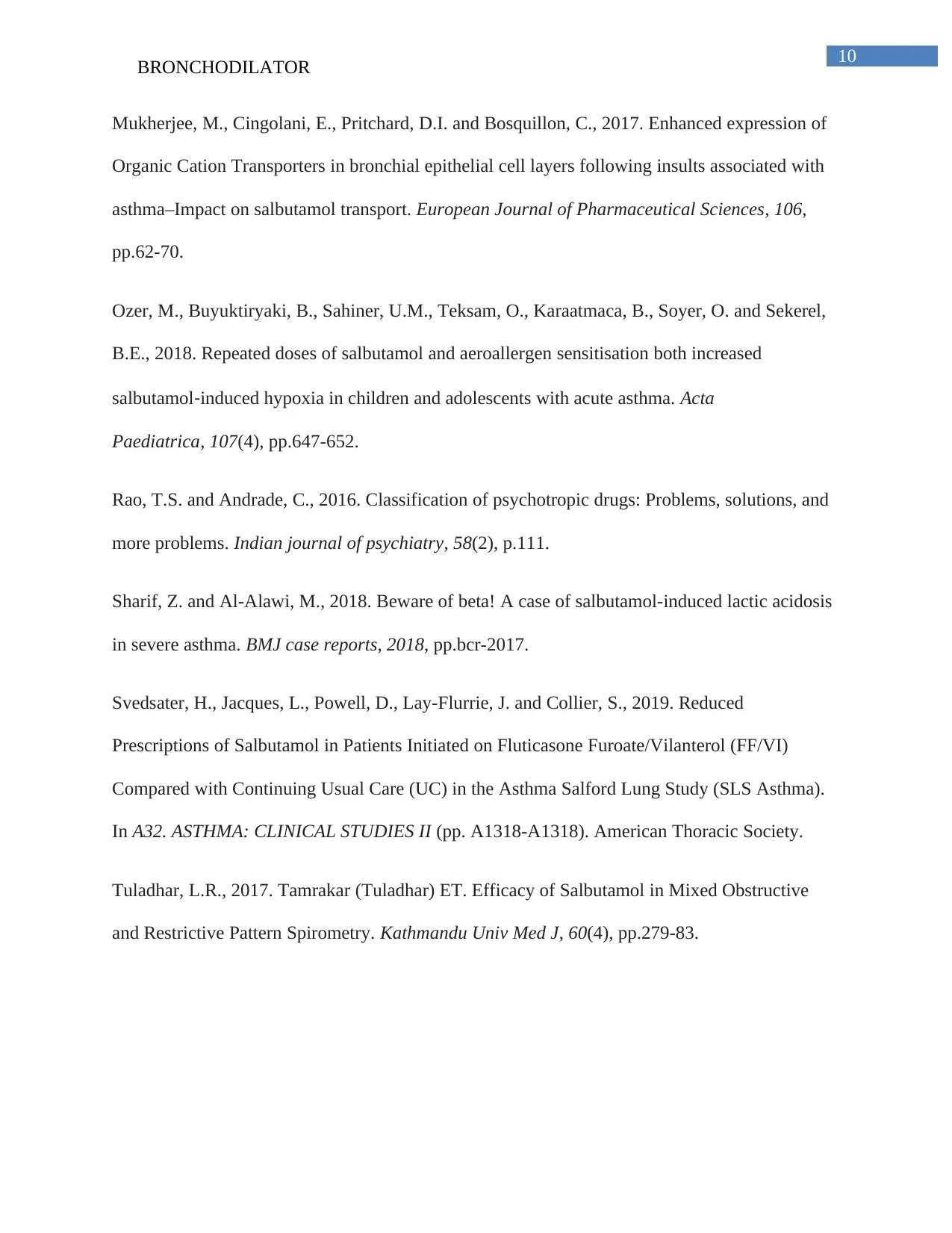
10
BRONCHODILATOR
Mukherjee, M., Cingolani, E., Pritchard, D.I. and Bosquillon, C., 2017. Enhanced expression of
Organic Cation Transporters in bronchial epithelial cell layers following insults associated with
asthma–Impact on salbutamol transport. European Journal of Pharmaceutical Sciences, 106,
pp.62-70.
Ozer, M., Buyuktiryaki, B., Sahiner, U.M., Teksam, O., Karaatmaca, B., Soyer, O. and Sekerel,
B.E., 2018. Repeated doses of salbutamol and aeroallergen sensitisation both increased
salbutamol‐induced hypoxia in children and adolescents with acute asthma. Acta
Paediatrica, 107(4), pp.647-652.
Rao, T.S. and Andrade, C., 2016. Classification of psychotropic drugs: Problems, solutions, and
more problems. Indian journal of psychiatry, 58(2), p.111.
Sharif, Z. and Al-Alawi, M., 2018. Beware of beta! A case of salbutamol-induced lactic acidosis
in severe asthma. BMJ case reports, 2018, pp.bcr-2017.
Svedsater, H., Jacques, L., Powell, D., Lay-Flurrie, J. and Collier, S., 2019. Reduced
Prescriptions of Salbutamol in Patients Initiated on Fluticasone Furoate/Vilanterol (FF/VI)
Compared with Continuing Usual Care (UC) in the Asthma Salford Lung Study (SLS Asthma).
In A32. ASTHMA: CLINICAL STUDIES II (pp. A1318-A1318). American Thoracic Society.
Tuladhar, L.R., 2017. Tamrakar (Tuladhar) ET. Efficacy of Salbutamol in Mixed Obstructive
and Restrictive Pattern Spirometry. Kathmandu Univ Med J, 60(4), pp.279-83.
BRONCHODILATOR
Mukherjee, M., Cingolani, E., Pritchard, D.I. and Bosquillon, C., 2017. Enhanced expression of
Organic Cation Transporters in bronchial epithelial cell layers following insults associated with
asthma–Impact on salbutamol transport. European Journal of Pharmaceutical Sciences, 106,
pp.62-70.
Ozer, M., Buyuktiryaki, B., Sahiner, U.M., Teksam, O., Karaatmaca, B., Soyer, O. and Sekerel,
B.E., 2018. Repeated doses of salbutamol and aeroallergen sensitisation both increased
salbutamol‐induced hypoxia in children and adolescents with acute asthma. Acta
Paediatrica, 107(4), pp.647-652.
Rao, T.S. and Andrade, C., 2016. Classification of psychotropic drugs: Problems, solutions, and
more problems. Indian journal of psychiatry, 58(2), p.111.
Sharif, Z. and Al-Alawi, M., 2018. Beware of beta! A case of salbutamol-induced lactic acidosis
in severe asthma. BMJ case reports, 2018, pp.bcr-2017.
Svedsater, H., Jacques, L., Powell, D., Lay-Flurrie, J. and Collier, S., 2019. Reduced
Prescriptions of Salbutamol in Patients Initiated on Fluticasone Furoate/Vilanterol (FF/VI)
Compared with Continuing Usual Care (UC) in the Asthma Salford Lung Study (SLS Asthma).
In A32. ASTHMA: CLINICAL STUDIES II (pp. A1318-A1318). American Thoracic Society.
Tuladhar, L.R., 2017. Tamrakar (Tuladhar) ET. Efficacy of Salbutamol in Mixed Obstructive
and Restrictive Pattern Spirometry. Kathmandu Univ Med J, 60(4), pp.279-83.

11
BRONCHODILATOR
BRONCHODILATOR
⊘ This is a preview!⊘
Do you want full access?
Subscribe today to unlock all pages.

Trusted by 1+ million students worldwide
1 out of 12
Related Documents
Your All-in-One AI-Powered Toolkit for Academic Success.
+13062052269
info@desklib.com
Available 24*7 on WhatsApp / Email
![[object Object]](/_next/static/media/star-bottom.7253800d.svg)
Unlock your academic potential
Copyright © 2020–2025 A2Z Services. All Rights Reserved. Developed and managed by ZUCOL.





